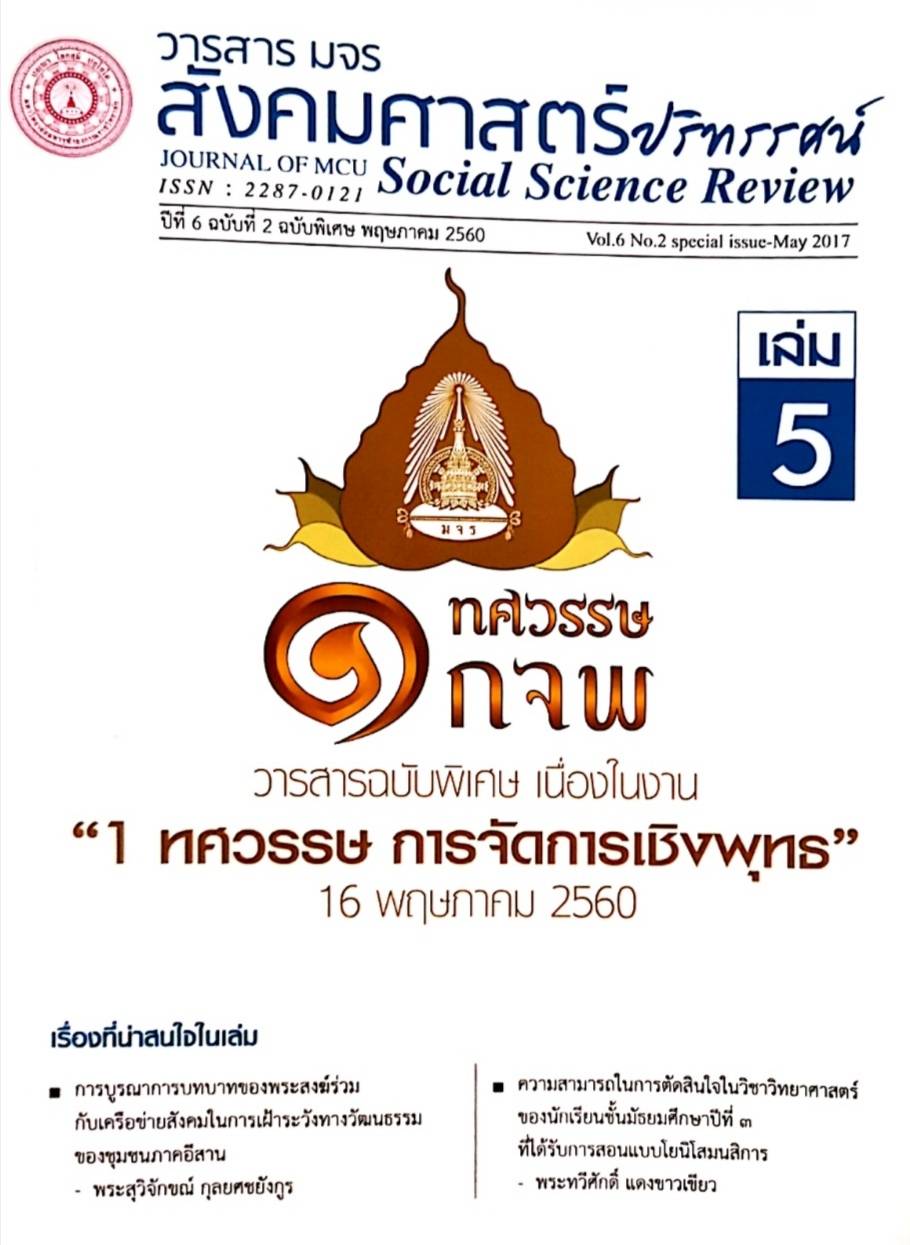ชุมชนเข้มแข็งเชิงพุทธบูรณาการ : กรณีศึกษากลุ่มสัจจะสะสมทรัพย์ ในภาคตะวันออกของประเทศไทย
คำสำคัญ:
ชุมชนเข้มแข็ง, สัจจะสะสมทรัพย์, การพึ่งพาตนเอง และพุทธบูรณาการบทคัดย่อ
บทความวิจัยครั้งนี้มีวัตถุประสงค์ดังนี้ 1) เพื่อศึกษาบริบททางสังคมและวิถีชีวิตของชุมชนในภาคตะวันออกก่อนการก่อตั้งกลุ่มสัจจะสะสมทรัพย์ 2) เพื่อศึกษาแนวคิด กระบวนการ ปัจจัย และเงื่อนไขในการสร้างชุมชนเข้มแข็งของกลุ่มสัจจะสะสมทรัพย์ในภาคตะวันออก และ 3) เพื่อวิเคราะห์รูปแบบการสร้างความเข้มแข็งของชุมชนเชิงพุทธบูรณาการผ่านกิจกรรมของกลุ่มสัจจะสะสมทรัพย์ในภาคตะวันออก ผลการวิจัยพบว่า 1) ในอดีตวิถีชีวิตของชุมชนในภาคตะวันออกเป็นชุมชนเกษตรกรรม ชาวบ้านอยู่อาศัยกันเป็นครอบครัวใหญ่ในพื้นที่ร่วมแรงร่วมใจกันช่วยเหลือกิจกรรมของชุมชน ภายหลังมีโรงงานอุตสาหกรรมเข้ามาในพื้นที่ ชาวบ้านเริ่มแตกแยกเป็นครอบครัวย่อย ไม่มีโอกาสได้รวมกลุ่มกันช่วยเหลืองานของชุมชนมากนัก กลุ่มสัจจะสะสมทรัพย์ได้ก่อตั้งขึ้น เพื่อช่วยเหลือปัญหาความยากจนของชาวบ้าน ทาให้ชาวบ้านมีความผูกพันกับชุมชนมากยิ่งขึ้น 2) แนวคิดและกระบวนการในการสร้างชุมชนเข้มแข็งของกลุ่มสัจจะสะสมทรัพย์ในจังหวัดตราด จันทบุรี และสระแก้ว เป็นแนวคิดที่เกิดจากการใช้ตัวเงินที่เป็นรูปธรรม และหลักธรรมที่เป็นนามธรรมมาผสมผสานกันอย่างลงตัว ส่งผลให้ชุมชนเกิดการพึ่งพาตนเอง และมีเม็ดเงินหมุนเวียนในชุมชนมากยิ่งขึ้น 3) ชุมชนเข้มแข็งเชิงพุทธบูรณาการเกิดขึ้นจากแนวคิดการใช้หลักธรรมนาหน้าตัวเงิน ชุมชนเข้มแข็งเชิงพุทธบูรณาการของกลุ่มสัจจะสะสมทรัพย์ตามองค์ความรู้ที่ได้ “SMART Model” ดังนี้ S = Self-reliance คือ การพึ่งพาตนเอง เป็นการใช้หลักธรรมสาหรับสงเคราะห์ให้ชุมชนเข้มแข็ง, M = Money คือ เงิน เป็นปัจจัยสำคัญที่ขับเคลื่อนให้ชุมชนพึ่งพาตนเองได้, A = Altruism คือ การเห็นแก่ประโยชน์ผู้อื่น เป็นแรงผลักดันสำคัญที่ส่งเสริมให้ชุมชนเข้มแข็ง, R = Responsibility คือ ความรับผิดชอบ เป็นหัวใจสำคัญในการเชื่อมต่อความสาเร็จให้เกิดขึ้น, T = Truth & Tolerance คือ ความซื่อสัตย์อดทน เป็นสิ่งที่ต้องปลูกฝังให้กับผู้มีส่วนเกี่ยวข้องทุกฝ่าย
เอกสารอ้างอิง
Aree CheuaMeuangPan. “Saving Groups : Financial Institution to develop the community”. Maejo Vision. 1 Vol. 2 August-September 2542.
Panus Pradolchob, et al. “Project : The Development of Cooperative Process at Trat Province”. Complete Research Report. Final Report Supported by The Thailand Research Fund (TRF), 2549. Theerangkoon Warabamrungkul. “The Development a knowledge management model for Sasjha Sasomsup Group in Trat Province”. A Thesis of The degree of Doctor of Philosophy. Development Education : Silpakorn University, 2556.
United Nations Development Program (UNDP). Human Development Report 1994. New York : Oxford University Press, 1994.
Lakkhana Termsirikulchai. “Social Capital and Health Movement : A Case Study of Sasjha Sasomsup in Trad Province”. A Thesis of The degree of Doctor of Philosophy. Medical and Health Social Sciences : Mahidol University, 2005.
ดาวน์โหลด
เผยแพร่แล้ว
รูปแบบการอ้างอิง
ฉบับ
ประเภทบทความ
สัญญาอนุญาต
ลิขสิทธิ์ (c) 2020 วารสาร มจร สังคมศาสตร์ปริทรรศน์

อนุญาตภายใต้เงื่อนไข Creative Commons Attribution-NonCommercial-NoDerivatives 4.0 International License.
เพื่อให้เป็นไปตามกฎหมายลิขสิทธิ์ ผู้นิพนธ์ทุกท่านต้องลงลายมือชื่อในแบบฟอร์มใบมอบลิขสิทธิ์บทความให้แก่วารสารฯ พร้อมกับบทความต้นฉบับที่ได้แก้ไขครั้งสุดท้าย นอกจากนี้ ผู้นิพนธ์ทุกท่านต้องยืนยันว่าบทความต้นฉบับที่ส่งมาตีพิมพ์นั้น ได้ส่งมาตีพิมพ์เฉพาะในวารสาร มจร สังคมศาสตร์ปริทรรศน์ เพียงแห่งเดียวเท่านั้น หากมีการใช้ภาพหรือตารางหรือเนื้อหาอื่นๆ ของผู้นิพนธ์อื่นที่ปรากฏในสิ่งตีพิมพ์อื่นมาแล้ว ผู้นิพนธ์ต้องขออนุญาตเจ้าของลิขสิทธิ์ก่อน พร้อมทั้งแสดงหนังสือที่ได้รับการยินยอมต่อบรรณาธิการ ก่อนที่บทความจะได้รับการตีพิมพ์ หากไม่เป็นไปตามข้อกำหนดเบื้องต้น ทางวารสารจะถอดบทความของท่านออกโดยไม่มีข้อยกเว้นใดๆ ทั้งสิ้น





